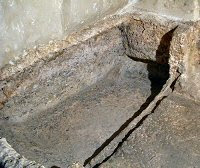 They spent some time in Tokyo and also in Nagasaki which Sean felt is a beautiful city.
They spent some time in Tokyo and also in Nagasaki which Sean felt is a beautiful city.Apparently you can't buy a car in Japan unless you can house it off-road, so car ownership is less common than in Britain and city traffic is not as congested as it is here. Public transport is good. They travelled by train while they were there and were impressed by the punctuality, the politeness of staff, and the respect that people show one another.
We talked about meeting at home in small groups and the sometimes subtle differences between church home groups, the cells of a cell church, and a network of house churches. Jim felt there is a real need for a group to feel like a family.
We also discussed holding another Moggerhanger-style meeting. If we do, Jim thought it would be useful to ask each group to share something about the style of their meetings, how they got started and so forth.
Jim explained that in the River Church's life group they had looked at Psalm 19. Verse 105 is especially striking, 'Your word is a lamp to my feet and a light for my path'. The psalms have themes, for example comfort is the theme of Psalm 23. It's important to recognise we have light for the journey.
Chris mentioned Job 23 which he'd read recently. It's clear that Job wanted a chance to meet Yahweh so he could put his case before him. The problem for Job was that Yahweh was unavailable. Wherever Job searched he was nowhere to be found. And the 'thick darkness' Job speaks of is mentioned a number of times in the Old Testament. This darkness (or hiddenness) prevents the contact Job so craves. Yet we learn from Paul that we are now 'hidden in Christ', in other words we are now on the other side of the veil of hiddenness, and that explains why the world cannot understand us. What a privilege we have!
Jim ran with this thought, reminding us that we know where we're going because Jesus has gone before us to prepare a place for us. His love is so deep, so high, so long and so wide! HalleluYah!






